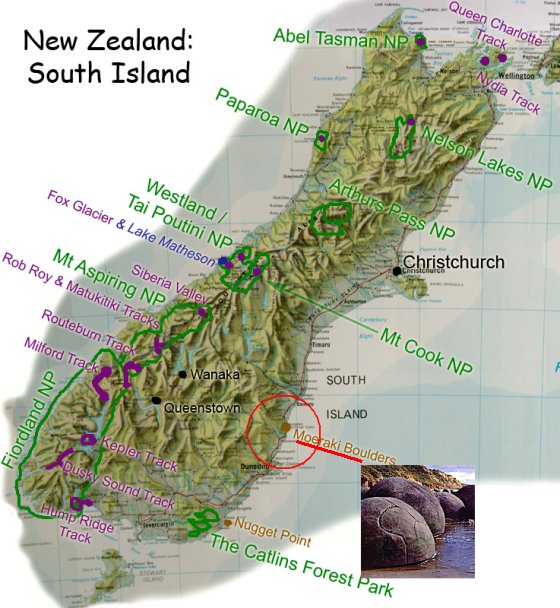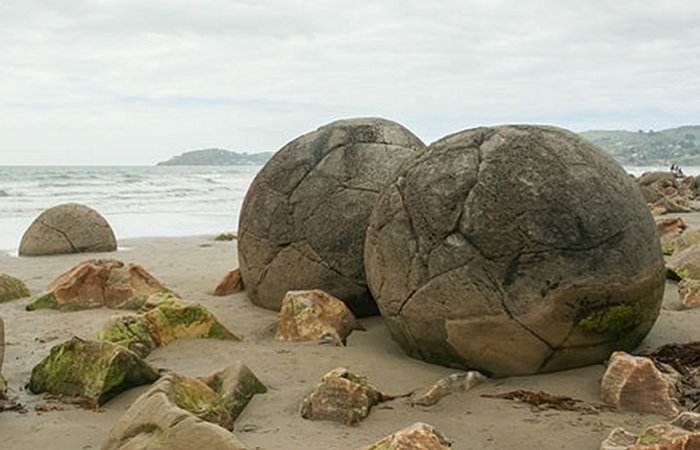Why Are The Billions Of Years Old Moeraki Boulders So Perfectly Round?
MessageToEagle.com – The beach north of Moeraki on New Zealand’s South Island is strewn with large, near-spherical boulders with bizarre cracked shells.
There are over 50 boulders on the beach, which range in size from 0.5m to just over 2.2m but can also be up to 3 meters wide.
Inside the boulders are numerous cracks, called septaria, which radiate outward from a hollow core filled with crystals.
Their origin is unclear and unexpected locations remain largely unexplained.
However, the most widely accepted scientific view is that they are mineral concretions – hard masses that formed 60 million years ago in mudstones—layers of softer sedimentary rocks (rocks which are laid down in oceans, lakes or rivers).
There, gradual erosion exposes and releases the boulders, which eventually roll down onto the beach.
People ask questions: why are they so perfectly round? Where did they come from? Are they some kind of fossils? Or perhaps alien eggs or strange unknown to humans energy storage devices?
The Maori people relate the remarkable spherical boulders to the wreck of the great canoe Arai Te Uru. As it was travelling south, the canoe foundered in a storm near Matakaea (Shag Point).
Its cargo was washed up on the nearby beaches – the round food baskets and water gourds are TeKai Hinaki (the Moeraki Boulders), while the seed kumara (sweet potatoes) are the irregularly shaped boulders further south.
The boulders and their origins continue to fascinate tourists, geologists and folklorists.
They have been also found in China, Israel and in Saint-André-de-Rosans in the Hautes-Alpes, France and Champ Island located in the central area of Franz Josef Land, Russia. Those found at Cape Triest are comparable Moeraki boulders in New Zealand. Other stone balls have been found in the village of Boguchanka in the north of Irkutsk region.
Diego Delso – CC BY-SA 3.0
The Moeraki Boulders are unique to New Zealand but not to the world. For example, boulders – 3 meters in diameter – have been found in the USA at Cannonball River within Morton and Sioux Counties of North Dakota, while boulders 4-6m across exist at the Frontier Formation in northeast Utah and central Wyoming.
Perhaps no other rocks found in Ohio generate so much public interest and curiosity than the large carbonate spheres, known as concretions, that weather out of the Devonian-age Ohio Shale. Along the outcrop belt of the Ohio Shale from Adams County on the Ohio River northward to Lake Erie, these orange-colored globes are a familiar sight as garden and yard ornaments and driveway markers.
Many of them reach 9 feet or more in diameter. There is much speculation on the origin of these giant formations.
The nature forms spherical fantastic stone formations. The geological process that originates them can last millions of years.
Copyright © MessageToEagle.com. All rights reserved. This material may not be published, broadcast, rewritten or redistributed in whole or part without the express written permission of MessageToEagle.com
Related Posts
-
 Have Super Aliens Already Left Our Visible Universe? A Closer Look At The Transcension Hypothesis
No Comments | Aug 3, 2013
Have Super Aliens Already Left Our Visible Universe? A Closer Look At The Transcension Hypothesis
No Comments | Aug 3, 2013 -
 Great Attractor: Mysterious Gravitational Anomaly Beyond Hydra-Centaurus Supercluster
No Comments | Jun 4, 2017
Great Attractor: Mysterious Gravitational Anomaly Beyond Hydra-Centaurus Supercluster
No Comments | Jun 4, 2017 -
 Vercingetorix: Greatest Of All Gallic Leaders And Hero Of The French People
No Comments | Dec 22, 2016
Vercingetorix: Greatest Of All Gallic Leaders And Hero Of The French People
No Comments | Dec 22, 2016 -
 Time Moves Faster The Farther Away You Are From The Surface Of The Earth
No Comments | Jan 30, 2016
Time Moves Faster The Farther Away You Are From The Surface Of The Earth
No Comments | Jan 30, 2016 -
 Artificial And Extraterrestrial Interference In The Development Of The Human Race
No Comments | May 6, 2015
Artificial And Extraterrestrial Interference In The Development Of The Human Race
No Comments | May 6, 2015 -
 Auroville – A City Free From Politics, Money And Religion
No Comments | Aug 27, 2018
Auroville – A City Free From Politics, Money And Religion
No Comments | Aug 27, 2018 -
 Dung Beetles Use Stars And The Night Sky To Navigate
No Comments | May 12, 2016
Dung Beetles Use Stars And The Night Sky To Navigate
No Comments | May 12, 2016 -
 Star Trek’s Version Of Time Travel Is More Realistic Than Most Science Fiction
No Comments | Jun 11, 2019
Star Trek’s Version Of Time Travel Is More Realistic Than Most Science Fiction
No Comments | Jun 11, 2019 -
 What Colors Can Newborn Babies See?
No Comments | Dec 30, 2015
What Colors Can Newborn Babies See?
No Comments | Dec 30, 2015 -
 Can Nanotechnology Help Us Create A Perfect Society?
No Comments | Nov 19, 2015
Can Nanotechnology Help Us Create A Perfect Society?
No Comments | Nov 19, 2015


